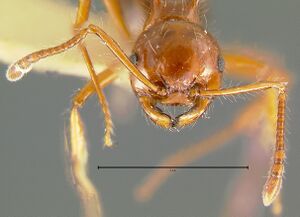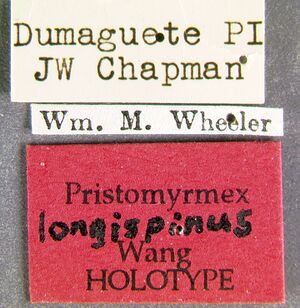Pristomyrmex longispinus
| Pristomyrmex longispinus | |
|---|---|

| |
| Scientific classification | |
| Kingdom: | Animalia |
| Phylum: | Arthropoda |
| Class: | Insecta |
| Order: | Hymenoptera |
| Family: | Formicidae |
| Subfamily: | Myrmicinae |
| Tribe: | Crematogastrini |
| Genus: | Pristomyrmex |
| Species: | P. longispinus |
| Binomial name | |
| Pristomyrmex longispinus Wang, M., 2003 | |
Zettel (2006) noted he observed workers of this species foraging on leaves, and that this is a rare sight for Pristomyrmex in general.
Identification
Wang (2003) - Worker. Frontal carinae short, usually not extending to the level of the posterior margins of eyes; pronotal spines exceptionally long (0.42-0.50); propodeal spines moderately long (0.18-0.26); anterior face of petiole node, in profile, indistinguishable from the upper surface of its anterior peduncle.
Pristomyrmex longispinus is closely related to Pristomyrmex curvulus. The former is very similar in the workers to the latter in the shape of pronotal and propodeal spines as well as in the size, sculpture, hair, and color of body. The differences between the two species are provided under P. curvulus.
A member of the Quadridens species group
Keys including this Species
Distribution
Latitudinal Distribution Pattern
Latitudinal Range: 9.3° to 9.3°.
| North Temperate |
North Subtropical |
Tropical | South Subtropical |
South Temperate |
- Source: AntMaps
Distribution based on Regional Taxon Lists
Indo-Australian Region: Philippines (type locality).
Distribution based on AntMaps
Distribution based on AntWeb specimens
Check data from AntWeb
Countries Occupied
| Number of countries occupied by this species based on AntWiki Regional Taxon Lists. In general, fewer countries occupied indicates a narrower range, while more countries indicates a more widespread species. |

|
Estimated Abundance
| Relative abundance based on number of AntMaps records per species (this species within the purple bar). Fewer records (to the left) indicates a less abundant/encountered species while more records (to the right) indicates more abundant/encountered species. |

|
Biology
|
Castes
Queens have yet to be collected.
Worker
   
| |
| . | Owned by Museum of Comparative Zoology. |
Nomenclature
The following information is derived from Barry Bolton's Online Catalogue of the Ants of the World.
- longispinus. Pristomyrmex longispinus Wang, M. 2003: 450, figs. 146-147, 263, 272 (w.m.) PHILIPPINES.
Unless otherwise noted the text for the remainder of this section is reported from the publication that includes the original description.
Description
Worker
Holotype. TL 5.30, HL 1.21, HW 1.28, CI 106, SL 1.34, SI 1.05, EL 0.24, PW 0.80, AL 1.26. Workers. TL 4 .52-5.62, HL 1.09-1.26, HW 1.15-1.3.5, CI 103-109, SL 1.26-1.40, SI 103-113, EL 0.21-0.26, PW 0.76-0.86, AL 1.14-1.32, PPW 0.31-0.35, PPL 0.36-0.40, PPI 84-89 (n = 20).
Mandibles generally unsculptured, smooth, and shining. Masticatory margin of mandible with four teeth: the strongest apical + the second strongest preapical + a long diastema + two small teeth that are roughly the same size. Basal margin of mandible lacking a toothlike prominence. Clypeus depressed, unsculptured, and shining; its anterior margin with a median denticle and usually two others on each side, but sometimes two lateral denticles are fused into one prominence. Ventral center of clypeus with a short transverse ruga or a broad-base d weak prominence. Palp formula 1,3. Frontal carinae short, usually not extending to the level of the posterior margins of the eyes. Antennal scrobes absent. Frontal lobes very weak so that the antennal articulations are almost entirely exposed. Antennal scapes long, when lying on the dorsal head, surpassing the occipital margin by about one-fifth to one-fourth of their length. Head in full-face view subglobal. Pronotum armed with a pair of exceptionally long spines that are about 0.42 to 0.50 and longer than the distance be tween their bases. Propodeum with a pair of moderately long spines that are 0.18 to 0.26 and over two times the distance be tween their bases. Both pronotal and propodeal spines acute and directed upward. Metapleural lobes subtriangular. Dorsum of alitrunk sometimes slightly concave. Anterior face of petiole node, in profile, indistinguishable from the dorsal surface of its anterior peduncle (i.e., the anterior face of petiole node and the dorsal surface of peduncle forming a long declivity from the base of peduncle to the top of petiole node). Postpetiole in profile rounded dorsally, in dorsal view longer than broad. Dorsum of head gene rally smooth and shining, but a few weak short rugae present on the frontal area and sometimes a few foveolate punctures on the genae. Alitrunk smooth and polished. Petiole, postpetiole, and gaster unsculptured, smooth, and shining. Dorsal surfaces of head and alitrunk with some erect or suberect long hairs. Usually two to three pairs of similar hairs present on the dorsal surfaces of petiole node and postpetiole, respectively. First gastral tergite usually lacking erect or suberect hairs, rarely with few hairs. A few pairs of forward-projecting hairs present near the anterior clypeal margin. Scapes and tibiae with some erect or suberect hairs. Color reddish-brown.
Male
Three male specimens, together with 48 workers, collected in Dumaguete, Philippines, by J. W. Chapman, constitute a series; and two of the three males were originally mounted, respectively, with a worker on the same pin: TL 4.42-4.54, HL 0.67- 0.73, HW 0.64-0.66, CI 88-96, SL 0.20-0.22, SI 31-34, HWE 0.94-0.98, EL 0.43-0.46, PW 0.88-0.93, AL 1.32-1.44, PPW 0.28-0.30, PPL 0.24-0.26, PPI 11.5-117 (n = 3).
Head, including the eyes, distinctly broader than long. Clypeus convex, without a median longitudinal carina. Palp formula 1,3. Frontal carinae sometimes absent but sometimes present, just reaching the level of the posterior margins of antennal insertions. Maximum length of the median ocellus 0.12 to 0.12. On the mesonotum, notauli pronounced, forming a Y shape; parapsidal furrows absent. Scutoscutellar sulcus with 12 to 13 narrow ridges. Middle and hind tibiae without any spurs. Propodeum slightly tuberculate, lacking spines and teeth. Metapleural lobes prominent and subtriangular. Petiole node in profile low, with a subtriangular apex and a rather long anterior peduncle; anterior face of the node, together with the dorsal surface of the peduncle, forming a long declivity that reaches the top of the node. Postpetiole in profile low, rounded dorsally, and in dorsal view broader than long. Dorsum of head smooth and shining, but frontal area usually with a median longitudinal carina. Alitrunk smooth and shining, except for those marked sutures. Petiole, postpetiole, and gaster unsculptured, smooth, and shining. All dorsal surfaces with abundant erect or suberect hairs. Scapes and tibiae with numerous erect or suberect short hairs. Color reddish-brown; hairs reddish-brown; wings somewhat infuscated.
Type Material
Holotype Worker. Museum of Comparative Zoology. Philippines: Dumaguete (J. W. Chapman). Paratypes. Paratypes, 73 workers and three males (The Natural History Museum, Los Angeles County Museum of Natural History, MCZC, Musee d'Histoire Naturelle Genève, National Museum of Natural History). Philippines
- Paratype, 3 workers, Dumaguete, Philippines, Chapman,J.W., ANIC32-017622, Australian National Insect Collection.
References
- Wang, M. 2003. A Monographic Revision of the Ant Genus Pristomyrmex (Hymenoptera:Formicidae). Bulletin of the Museum of Comparative Zoology 157(6): 383-542 (page 450, fig. 146-147, 263, 272 worker, male described)
- Zettel, H. 2006. On the ants of the Philippine Islands: 1. The genus Pristomyrmex Mayr, 1866. Myrmecologische Nachrichten 8:59-68.
References based on Global Ant Biodiversity Informatics
- Wang M. 2003. A monographic revision of the ant genus Pristomyrmex (Hymenoptera:Formicidae). Bulletin of the Museum of Comparative Zoology 157(6):383-542

